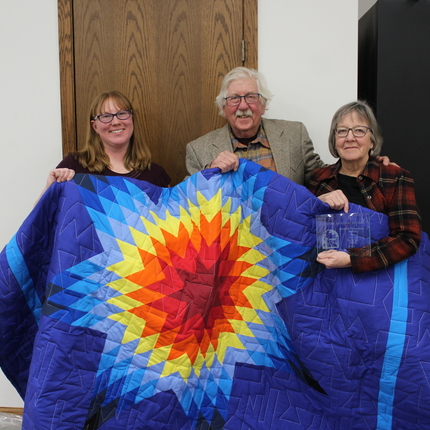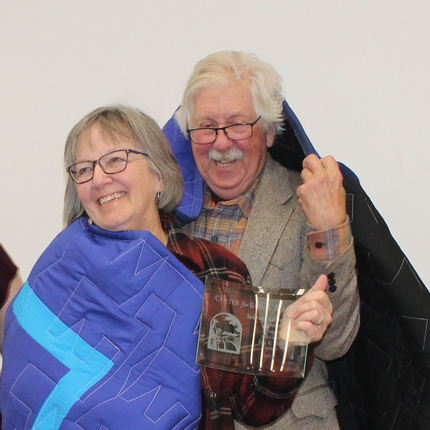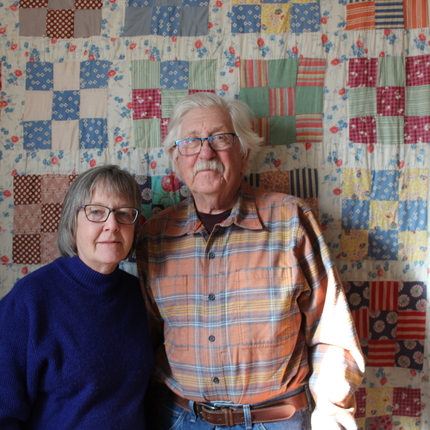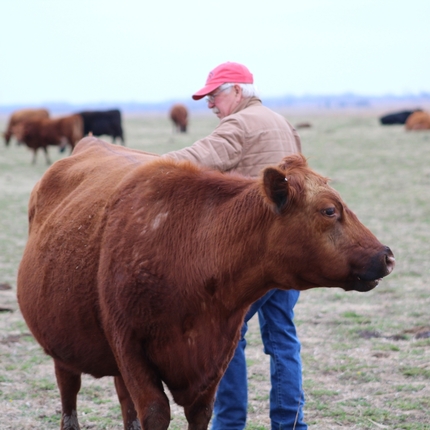Jim and Lisa French aren’t rich farmers, but they have lived a rich life.
“We’ve been really blessed, just so blessed,” Jim said.
The Partridge, Kansas, couple has dedicated their lives to community, healthy water, soil health, and conservation. That’s why they are the Center for Rural Affairs’ 2022 Seventh Generation Award recipients.
“You look seven generations forward,” Jim said. “You look at the things that we’re doing now. Will it have an impact upon that generation? We don’t know all the seeds we’ve planted, but we’ve tried to look toward the generations that we are borrowing from right now.”
Early this year, Center Executive Director Brian Depew called the Frenches to share the news of their award. Then, Rhea Landholm, Center communications manager, presented the award at the Reno County Conservation District annual meeting on Feb. 23.
“I was just kind of stunned when Brian called,” Jim said. “Really humbled, but just joyful. Things have come full circle. We start to think that hopefully our work will have an impact on the future.”
Getting to the roots
Both Jim and Lisa were born in Reno County, Kansas, and grew up within five miles of where they live now. They went to school together and started dating when they were in high school.
In 1977, both attended graduate school at the University of Nebraska-Lincoln, where Jim took classes from Paul Olson in the English Department. Paul, who became a Center board member in the late 1970s, introduced the couple to the organization.
Then, in 1979, they moved back to Reno County and took over management of the farm in 1981. Jim said they followed all of Marty Strange’s rules of thumb, as laid out in the book, “Family Farming: A New Economic Vision.”
They now live on the farm Jim’s grandfather purchased in 1909 from Lisa’s family. Jim grew up on this farm, helping shear sheep and working for his father through high school. When his grandparents lived on the farm, he remembers that his grandmother’s gardening was guided by a copy of “Malabar Farm,” which focuses on basic caring for the soil and farm.
When Jim and Lisa took over, they did a wheat/milo rotation with livestock.
“I think, maybe because of the connection with the Center for Rural Affairs, and also then Wes Jackson (of the Land Institute), we thought, how do you model the prairie,” Lisa said. “That began to guide changes that we made.”
They didn’t ever go into organic production, but were always thinking how they could reduce inputs by changing their management practices.
“Dad was that way, too,” said Jim. “He always complained that the farm programs penalized the people that had been doing rotations and had alfalfa. And the guys who got the bigger checks were just fence row to fence row in cash crops.”
The animals have always been important, as well.
“Both of us, too, we really enjoyed nature. And the uncultivated part of where we lived,” Jim said. “We felt like if the wild animals were doing well, we must be doing some things right.”
In 1984, one of the changes they made was planting Austrian winter peas as a cover crop to fix nitrogen. That was successful, Jim said, but the use of cover crops has been more developed over the past 30 to 40 years.
“I don’t think we quite understood the concept of soil health and what tools you can use to build soil health,” Lisa said. “We were thinking more in terms of reducing inputs at that point. But, we have a better understanding now.”
“Much better,” Jim added. “It’s just been a revolution in the way we think about soil and how we mimic nature.”
Over the years, they focused less on crops like wheat and grain sorghum and planted more and more forages or forage crops. And, they count on the cash crop to also be a forage crop. About 20 years ago, they put a little more than 100 acres of their land into native grass. They also managed a registered Gelbvieh herd for more than 20 years until transitioning to a grass-based Red Angus herd in 2004.
This year, in large part because of severe drought in the region, Jim and Lisa decided to farm less and leased out some cattle. They kept a group of bred and yearling heifers and are putting their larger focus on regenerative ag.
“Just to give ourselves some space to do some other things,” Lisa said.
“Failure is not going to drive us off the land. But, maybe we can learn some lessons here,” Jim said. “We have a little more slack. Maybe we can try some things, take a little more risk, and others can learn from what we try. We look at it in ways that can improve our land, make it better in the face of climate change. Maybe we can help find ways to fight climate change and teach others.”
Working for soil health
In the late 1980s, the Frenches were looking for a Kansas counterpart to the Center for Rural Affairs and connected with the Kansas Rural Center. They both eventually served on the board of directors and worked there, Jim doing policy and communications work and Lisa working on water quality. In the early 1990s, they also were involved in a Kansas Rural Center mentoring group called the “Resourceful Farmers.”
“The Kansas Rural Center had lots of different mentoring groups, and people doing all kinds of things whether it was value-added, reducing inputs, or alternative crops,” Jim said. “As it finished, we said, ‘We need to tell these stories.’ So, I did that for about, maybe four or five years, just interviewing and writing stories. Just trying to give exposure about other ways to make a living in rural America. So it was kind of all centered in trying to revitalize rural culture through sustainable agriculture and value-added enterprises.”
Those stories led Jim to Oxfam America, where he worked for 12 years. He first focused on trade policy and then payment limitations, working hand-in-hand with the Center for Rural Affairs on the latter.
“The way we subsidize agriculture creates consolidation and actually hurts rural communities,” Jim said. “It causes farmers to get larger and provides less opportunities for young people. If there are fewer farmers and fewer children, the schools suffer. The local communities suffer.”
Other Oxfam initiatives that Jim worked on were “Make Trade Fair,” focused on cotton farmers in the least developed nations in Africa; a campaign on cap and trade that highlighted small farmers and women who were experiencing a collapse of the climate; the Global Food Security Act; and “Behind the Brands,” which centered on the impact of the largest food companies, especially regarding women in agriculture.
“We focused so much on women because, globally, women are the ones who not only prepare most of the world’s food, but they are also the ones who grow most of the food crops,” Jim said. “We looked at child labor, worker rights, and a lot of different things, but climate change was one of them.”
Meanwhile, Lisa was working on water quality at the Kansas Rural Center in the 1990s. She helped farmers do self-assessments, then helped them apply for conservation funds to improve their farms. About that time, people became aware the Cheney Lake Watershed was having issues. Algae blooms were in the main water supply for Wichita, and farmers were seeing bank erosion.
“Farmers were concerned about what was happening with the reservoir and the city was concerned about their water quality,” Lisa said.
In 2002, Lisa was hired to head up a water quality project effort that worked with farmers in a five-county region. She retired from that position in October 2022.
“It was a great project based on local leadership,” she said. “A board of seven farmers and landowners directed the project. It was also a wonderful example of a rural/urban partnership.”
Farmers could enroll in a state cost-share or an Environmental Quality Incentive Program (EQIP) cost-share from the U.S. Department of Agriculture to create terraces, watering systems for livestock, or other initiatives. The city of Wichita paid a part, covering most of the farmers’ costs.
In about 2015, Jim worked on the “Behind the Brands” initiative, urging General Mills and Kelloggs to work on soil health.
“In their supply chain, they have the potential to influence the way these crops are grown,” he said. “We requested them to significantly decrease the amount of emissions and also to have carbon go back into the soil.”
Jim recalls standing in 6 inches of snow in Golden Valley, Minnesota, in front of the General Mills headquarters, alongside characters dressed up like the Jolly Green Giant and the Twix Rabbit. They held up signs like “Help in poverty and hunger General Mills” and “Fight climate change.”
“It was the most satisfying campaign I ever was a part of,” Jim said.
Within the next year, General Mills resolved to look at its supply chain. By 2019, the company announced its commitment to advance regenerative agriculture practices on 1 million acres of farmland by 2030. In Kansas, it approached Lisa and the Cheney Lake Watershed to help it promote soil health with Kansas wheat farmers.
General Mills began sponsoring Soil Health schools and workshops for farmers. A mentorship program was developed, which involved about 25 farmers, including the Frenches.
“Things really just snowballed,” Lisa said. “I was real proud of all the things we did. The work that we’d done early on on cover crops fit right in. Now, we have a whole contingent of farmers around here who are working really hard on soil health.”
Getting involved
Both Jim and Lisa have been involved in policy advocacy alongside the Center for Rural Affairs. In 1990, they participated in a Center and Sustainable Agriculture Coalition jointly sponsored fly-in to Washington, D.C., to visit lawmakers.
Then, Jim worked closely with the Center campaign on payment limits during the 2008 farm bill. He was also a consultant with the Center on the 2018 farm bill.
And, Jim and Lisa have faithfully donated to the Center for Rural Affairs annually.
“The Center really embodies that connection between our earth, our community, and our relationships,” Jim said. “It’s one of the few organizations that has always approached it that way. The environment isn’t separated from farming; they have to work together.”
Jim and Lisa said they’ve admired the Center’s work on immigrant communities, small businesses, and entrepreneurship.
Lisa, who has been on the board of the Hutchinson (Kansas) Community Foundation for 10 years, said the Center for Rural Affairs has had an influence on her community work.
One of the community foundation’s newest initiatives is impact investing with recent contributions to rural broadband, Main Street businesses, and building renovations.
“The Center has long advocated for that kind of thing,” Jim said. “The work that the Center and others have done, like investing in your local community, sometimes may not pay off the highest return, but the returns aren’t always measurable in terms of money. The returns are in places that have schools with children, farms that are healthy. Those are the kinds of things that we need to look at.”
Their children, Andrew and Ruth Anne, both have careers as attorneys. Andrew has a focus on environmental law and energy policy while Ruth Anne focuses on social justice. Ruth Anne and her family recently invested in 80 acres in the county.
Jim and Lisa are also proud grandparents of 14-year-old and 9-month-old grandsons.
Both Jim and Lisa have served in many capacities for their church, educational institutions, agricultural organizations, water and ag policy advisory committees.
Feature photo: Rhea Landholm, Center communications manager, presents Jim and Lisa French, of Partridge, Kansas, the 2022 Seventh Generation Award at the Reno County Conservation annual meeting. They also received a Native American star quilt. | Top two photos by Pastor Sheridan Irick








